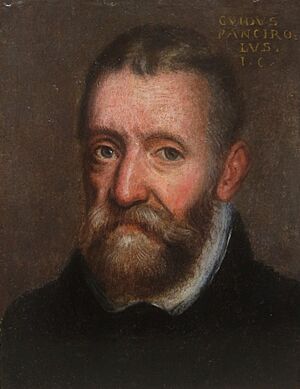Guido Panciroli facts for kids
Quick facts for kids
Guido Panciroli
|
|
|---|---|

Guido Panciroli – Oil painting, an artist in the circle of Tintoretto
|
|
| Born | 17 April 1523 Reggio Emilia, Italy
|
| Died | 5 March 1599 (aged 75) Padova, Italy
|
| Nationality | Italian |
| Education | University of Ferrara |
| Occupation | Jurist, law professor, historian, and antiquarian |
Guido Panciroli (born April 17, 1523 – died March 5, 1599) was an important Italian scholar from the 1500s. He was an antiquarian (someone who studies old things), a historian, and a jurist (a legal expert). He taught law at universities in Ferrara, Padua, and Turin. During his life, he was famous for his knowledge of law, and students came from all over Europe to learn from him. After he died, he became well known for a special book called Rerum memorabilium, iam olim deperditarum. This book talked about all the knowledge that had been lost since ancient times.
Contents
Guido Panciroli's Life Story
Guido Panciroli was born in Reggio Emilia, Italy, on April 17, 1523. His father, Alberto Panciroli, was also a legal expert. When Guido was young, he received a great education in classical studies, which included history and literature.
In 1540, he went to Ferrara to study law. He finished his studies on October 25, 1547. After graduating, he started teaching law in Padua. Later, in 1570, he moved to Turin to continue his teaching career.
Teaching and Influence
Guido Panciroli was supported by the Duke of Savoy, Emmanuel Philibert, Duke of Savoy. The Duke hired him to teach civil law. Panciroli received a very good salary for his work.
He was special because he brought his knowledge of history and humanism (a way of thinking that focuses on human values and achievements) into the study of law. This made his teaching very unique and influential. Near the end of his life, two popes, Pope Gregory XIV and Clement VIII, asked him to be an "auditor" for the Roman Rota. This was a high legal position in the Catholic Church, but Panciroli chose to refuse it.
Panciroli wrote many books during his lifetime. Some of his writings, like Rerum memorabilium, were not officially published right away. However, copies of these handwritten works were shared widely across Europe. They became very important and influenced many scholars.
Another important book by Panciroli was De claris legum interpretibus libri quatuor. This book was an early history of ancient Roman and medieval law. Even though it wasn't perfect, it was the most complete history of law available at the time. It became very important in legal studies.
Guido Panciroli passed away in Padova on March 5, 1599. His funeral was a large public event, attended by many people. His nephew, Ottavio, later wrote a short book about Guido's life in 1637.
Rerum memorabilium: A Book About Lost Knowledge
Panciroli's famous book, Rerum memorabilium, iam olim deperditarum, was first requested by his supporter, Emmanuel Philibert, Duke of Savoy. The Duke wanted a book that would show "the majesty and grandeur, the glory and greatness of [...] the whole universe".
The book was first written in Italian. However, it wasn't published in Italian until 1612. The first published version was a Latin translation by Panciroli's student, Heinrich Salmuth, in 1599 and 1602. This Latin version became very popular because Latin was the main language used by scholars across Europe at that time.
The book quickly spread throughout Europe. It was translated into French in 1617. Parts of it were translated into English in 1638 by Henry Peacham. A full English translation came out in 1715.
What the Book Was About
In Rerum memorabilium, Panciroli tried to list all the wisdom and knowledge that had been lost since ancient times. He called these lost things deperdita. His book mainly focused on lost knowledge in natural philosophy (early science), alchemy, and medicine. He didn't focus as much on lost ideas about philosophy, government, or religion.
This book had a big impact on writers during the Renaissance. It encouraged them to study ancient works of technology and science again. They wanted to rediscover these "lost things" (deperdita). This was different from the Middle Ages, which focused more on ancient philosophy.
According to a historian named Vera Keller, Panciroli's book inspired thinkers like Francis Bacon and Thomas Hobbes. It made them think about "things wanted" or desiderata, such as immortality or a universal language. Many of the "lost things" Panciroli wrote about appeared on popular "wish-lists" of "things wanted" in the 1600s.
Guido Panciroli's Works
- De Magistratibus Municipalibus, et Corporibus artificum
- De quatuordecim regionibus Urbis Romae, earumdemque aedificiis tam publicis, quam privatis
- De Rebus Bellicis
- Rerum historicarum patriae suae libri octo
- De claris iurisconsultis
- Thesaurus variarum lectionum utriusque iuris
- Rerum memorabilium, iam olim deperditarum et contra recens atque ingeniose inventarum libri duo
- Raccolta breve d’alcune cose più segnalate ch’ebbero gli antichi, e d’alcune altre trovate dai moderni
- Livre premier des antiquitez perdues, et si au vif representées par la plume
- The History of Many Memorable Things Lost, which Were in Use Among the Ancients
- Consiliorum siue responsorum iuris d. Guidi Panciroli Regiensis
- Civilium iudiciorum praxis sive Ordo iudiciarius
Images for kids


